https://en.wikipedia.org/wiki/Mahabalipuram
Mahabalipuram
From Wikipedia, the free encyclopedia
For the film, see Mahabalipuram (film).
| mmm மாமல்லபுரம் Mahabalipuram | |
|---|---|
| town | |
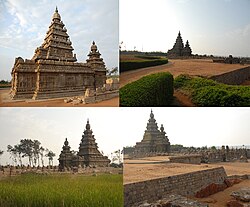
View of Shore Temple, Mahabalipuram / Mamallapuram
| |
| Coordinates: 12°36′59″N 80°11′58″ECoordinates: 12°36′59″N 80°11′58″E | |
| Country | India |
| State | Tamil Nadu |
| District | Kancheepuram |
| Elevation | 12 m (39 ft) |
| Population (2001) | |
| • Total | 12,049 |
| Languages | |
| • Official | Tamil |
| Time zone | IST (UTC+5:30) |
| PIN | 603104 |
| Telephone code | 91-44 |
Mahabalipuram, also known as Mamallapuram is a town in Kancheepuram district in the Indian state of Tamil Nadu. It is around 60 km south from the city of Chennai. It is an ancient historic town and was a bustling seaport during the time of Periplus (1st century CE) and Ptolemy (140 CE). Ancient IndianTRADERS who went to countries of South East Asia sailed from the seaport of Mahabalipuram.
who went to countries of South East Asia sailed from the seaport of Mahabalipuram.
 who went to countries of South East Asia sailed from the seaport of Mahabalipuram.
who went to countries of South East Asia sailed from the seaport of Mahabalipuram.
By the 7th century it was a port city of South Indian dynasty of the Pallavas. It has a group of sanctuaries, which was carved out of rock along the Coromandel coast in the 7th and 8th centuries : rathas (temples in the form of chariots),mandapas (cave sanctuaries), giant open-air reliefs such as the famous 'Descent of the Ganges', and the Shore Temple, with thousands of sculptures to the glory of Shiva. The group of monuments at Mahabalipuram has been classified as a UNESCO World Heritage Site.
It has an average elevation of 12 metres (39 feet). The modern city of Mahabalipuram was established by the British Raj in 1827.[1]
Contents
[hide]History[edit]
[Megalithic burial urn, cairn circles and jars with burials dating to the very dawn of the Christian era have been discovered near Mamallapuram. The Sangam age poem Perumpāṇāṟṟuppaṭai relates the rule of King Thondaiman Ilam Thiraiyar at Kanchipuram of the Tondai Nadu port Nirppeyyaru which scholars identify with the present-day Mamallapuram. Chinese coins and Roman coins of Theodosius I in the 4th century CE have been found at Mamallapuram revealing the port as an active hub ofGLOBAL TRADE in the late classical period. Two Pallavacoins bearing legends read as Srihari and Srinidhi have been found at Mamallapuram. The Pallava kings ruled Mamallapuram from Kanchipuram; the capital of the Pallava dynasty from the 3rd century to 9th century CE, and used the port to launchTRADE
in the late classical period. Two Pallavacoins bearing legends read as Srihari and Srinidhi have been found at Mamallapuram. The Pallava kings ruled Mamallapuram from Kanchipuram; the capital of the Pallava dynasty from the 3rd century to 9th century CE, and used the port to launchTRADE and diplomatic missions to Sri Lanka and Southeast Asia.
and diplomatic missions to Sri Lanka and Southeast Asia.
 in the late classical period. Two Pallavacoins bearing legends read as Srihari and Srinidhi have been found at Mamallapuram. The Pallava kings ruled Mamallapuram from Kanchipuram; the capital of the Pallava dynasty from the 3rd century to 9th century CE, and used the port to launchTRADE
in the late classical period. Two Pallavacoins bearing legends read as Srihari and Srinidhi have been found at Mamallapuram. The Pallava kings ruled Mamallapuram from Kanchipuram; the capital of the Pallava dynasty from the 3rd century to 9th century CE, and used the port to launchTRADE and diplomatic missions to Sri Lanka and Southeast Asia.
and diplomatic missions to Sri Lanka and Southeast Asia.
An 8th-century Tamil text written by Thirumangai Alvar described this place as Sea Mountain ‘where the ships rode at anchor bent to the point of breaking laden as they were with wealth, big trunked elephants and gems of nine varieties in heaps’. It is also known by several other names such as Mamallapattana and Mamallapuram. Another name by which Mahabalipuram has been known to mariners, at least since Marco Polo’s time is "Seven Pagodas" alluding to the Seven Pagodas of Mahabalipuram that stood on the shore, of which one, the Shore Temple, survives.[2]
The temples of Mamallapuram, portraying events described in the Mahabharata, were built largely during the reigns of Narasimhavarman and his successor Rajasimhavarman and showcase the movement from rock-cut architecture to structural building. The city of Mahabalipuram was largely developed by the Pallava king Narasimhavarman I in the 7th century AD.[2] The mandapa or pavilions and the rathas or shrines shaped as templechariots are hewn from the granite rock face, while the famed Shore Temple, erected half a century later, is built from dressed stone. What makes Mamallapuram so culturally resonant are the influences it absorbs and disseminates. The Shore Temple includes many bas reliefs, including one 100 ft. long and 45 ft. high, carved out of granite.[3]
All but one of the rathas from the first phase of Pallava architecture are modeled on the Buddhist viharas or monasteries and chaitya halls with several cells arranged around a courtyard.[4] Art historian Percy Brown, in fact, traces the possible roots of the Pallava Mandapa to the similar rock-cut caves of Ajanta Cavesand Ellora Caves. Referring to Narasimhavarman's victory in AD 642 over the Chalukyan king Pulakesin II, Brown says the Pallava king may have brought the sculptors and artisans back to Kanchi and Mamallapuram as 'spoils of war'.[5]
The fact that different shrines were dedicated to different deities is evidence of an increased sectarianism at the time of their construction. A bas-relief on a sculpted cliff has an image of Shiva and a shrine dedicated to Vishnu, indicating the growing importance of these Sangam period deities and a weakening of the roles of Vedic gods such as Indra and Soma.[6]
Transport[edit]
MTC and TNSTC (Villupuram) Kanchipuram division buses are operating bus from Chennai, Chengalpattu, Kancheepuram, Thiruttani etc. Apart from TNSTC MTC operating buses to Mamallapuram from various parts of the city with Deluxe and Air conditioned Deluxe buses
MTC bus Routes towards Mamallapuram
| Route Number | Start | End | Via |
|---|---|---|---|
| 515 | Tambaram | Mamallapuram | Vandalore Zoo, Kelambakkam, Thirupporur |
| 568 | Adyar | Mamallapuram | Perugudi, Sholinganallur, Kelambakkam, Thirupporur |
| 568C | Koyambedu | Mamallapuram | Vadapalani, Ashok nagar, Guindy, Madhya kailash, Perugudi, Sholinganallur, Kelambakkam, Thirupporur |
| 588 | Adyar | Mamallapuram | Thiruvanmiyur, VGP, MGM, Kovalam, Thiruvedanthai, Vadanemmeli, Devanery |
| 588B | Broadway | Mamallapuram | Annasquare,AIR, Santhome, AMS, Adyar, Thiruvanmiyur, VGP, MGM, Kovalam, Thiruvedanthai, Vadanemmeli, Devanery
THIS ROUTE IS AVAILABLE ONLY ON SUNDAY AND GOVERNMENT HOLIDAYS
|
| 588C | Koyambedu | Mamallapuram | Vadapalani, Ashok nagar, Guindy, Madhya kailash, Thiruvanmiyur, VGP, MGM, Kovalam, Thiruvedanthai, Vadanemmeli, Devanery |
| 589 | Velachery | Mamallapuram | SRP Tools, Thiruvanmiyur, VGP, MGM, Kovalam, Thiruvedanthai, Vadanemmeli, Devanery |
| 599 | Mamallapuram | T Nagar | Saidapet, Adyar, Thiruvanmiyur, VGP, MGM, Kovalam, Thiruvedanthai, Vadanemmeli, Devanery |
Landmarks[edit]
The monuments are mostly rock-cut and monolithic, and constitute the early stages of Dravidian architecture where in Buddhist elements of design are prominently visible. They are constituted by cave temples, monolithic rathas(chariots), sculpted reliefs and structural temples. The pillars are of the Dravidian order. The sculptures are excellent examples of Pallava art. They are located in the side of the cliffs near India's Bay of Bengal.
It is believed by some that this area served as a school for young sculptors. The different sculptures, some half finished, may have been examples of different styles of architecture, probably demonstrated by instructors and practiced on by young students. This can be seen in the Pancha Rathas where each Ratha is sculpted in a different style. These five Rathas were all carved out of a single piece of granite in situ.[3] While excavating Khajuraho, Alex Evans, a stonemason and sculptor, recreated a stone sculpture made out of sandstone, which is softer than granite, under 4 feet that took about 60 days to carve. The carving at Mahabalipuram must have required hundreds of highly skilled sculptors.[7]
In 2004 the Indian Ocean Tsunami washed away tons of coastal sand exposing structures including a granite lion and an elephant relief. [8]
Some important structures include:
- Thirukadalmallai, the temple dedicated to Lord Vishnu. It was also built by Pallava King in order to safeguard the sculptures from the ocean. It is told that after building this temple, the remaining architecture was preserved and was not corroded by sea.
- Descent of the Ganges or Bagiratha's Penance – a giant open-air bas relief
- Varaha Cave Temple – a small rock-cut temple dating back to the 7th century.
- The Shore Temple – a structural temple along the Bay of Bengal with the entrance from the western side away from the sea. Recent excavations have revealed new structures here.
- Pancha Rathas (Five Chariots) – five monolithic pyramidal structures named after the Pandavas (Arjuna, Bhima, Yudhishtra, Nakula and Sahadeva) andDraupadi. An interesting aspect of the rathas is that, despite their sizes they are not assembled – each of these is carved from one single large piece of stone.
- Light House, built in 1894.
Demography[edit]
As of 2001 India census,[9] Mahabalipuram had a population of 12,345.[10] Males constitute 52% of the population and females 48%. Mahabalipuram has an average literacy rate of 74%, higher than the national average of 59.5%: male literacy is 82%, and female literacy is 66%. In Mahabalipuram, 12% of the population is under 6 years of age.










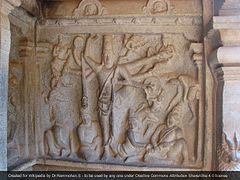
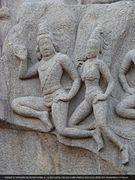

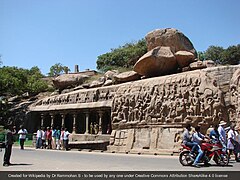
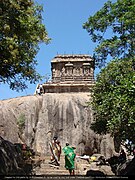











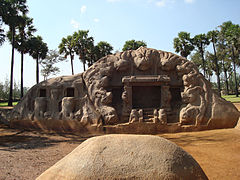














No comments:
Post a Comment